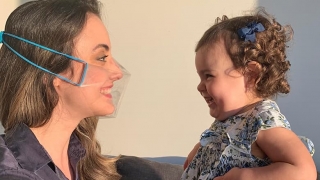Transparent Mask Offers Clear Advantages During Patient Interactions
Published on
Published on
 When the COVID-19 pandemic began, so too did a new reality where the faces we see in public are half-covered by masks. Concern quickly arose from various teams within Children’s Hospital of Philadelphia (CHOP) about the impact facial masking would have on interactions with patients. Just as quickly, Maria Velez, MD, a clinical researcher with the CHOP Additive Manufacturing for Pediatric 3-D Printing Lab (also known as the CHAMP Lab) had a solution for a way to bring facial expressions back into the world: a transparent origami face mask.
When the COVID-19 pandemic began, so too did a new reality where the faces we see in public are half-covered by masks. Concern quickly arose from various teams within Children’s Hospital of Philadelphia (CHOP) about the impact facial masking would have on interactions with patients. Just as quickly, Maria Velez, MD, a clinical researcher with the CHOP Additive Manufacturing for Pediatric 3-D Printing Lab (also known as the CHAMP Lab) had a solution for a way to bring facial expressions back into the world: a transparent origami face mask.
“In pediatrics, a transparent mask is especially helpful for vulnerable populations, including children who are deaf or hearing impaired, children whose brains are developing, and those who have behavioral or cognitive disabilities,” says Velez.
While clear face masks do exist on the market, none were readily available for order at the height of the pandemic. The CHAMP lab supports additive manufacturing and 3-D printing efforts across the hospital including surgical models, medical devices and educational tools. The CHAMP team and CHOP’s Innovation Ecosystem worked to develop several devices and tools to support COVID efforts, one of which was Velez’s mask.
“The CHAMP team had to be resourceful,” says Velez, who put her origami skills to use to create a blueprint for a transparent, reusable, plastic, DIY face mask.
The face mask — now known as Clarity: The Transparent Origami Face Mask — provides a surgical mask level of protection against the coronavirus while also offering full face visibility. It reveals the facial expressions of caregivers and improves patient/family communication.
The Clarity mask has been used by CHOP postdoctoral fellow Mina Kim, PhD, NCSP, who assesses the communication skills and social interactions of children with autism spectrum disorders (ASD). Children with ASD can have difficulty understanding social cues and emotions. Before the Clarity mask was available, Dr. Kim worried that administering the assessment with a medical mask covering her face would affect a patient’s responses and impact the validity of results.
“The Clarity mask helps remove the impression of us as scary people with all of this gear on,” says Dr. Kim. “We feel safe wearing the mask and it feels more natural. At a time when we really had a need for them, the Department of Radiology was able to provide us with a solution.”
Similarly, the neonatology team worried that the inability to see facial expressions would have developmental repercussions for newborn babies. An alternative to the typical face mask was also needed by psychologists who work with children still developing facial recognition and emotional perception skills, and speech therapists, who often rely on lip reading and facial expressions to communicate with children who are deaf and hard of hearing.
To date, more than 300 Clarity masks have been manufactured and distributed to CHOP staff. The mask has earned national recognition, earning an award in the “Make Your Medical Device Pitch for Kids!” competition presented by the FDA-sponsored National Capital Consortium for Pediatric Device Innovation.
See how to create your own DIY clarity mask
The CHOP Additive Manufacturing for Pediatric 3-D Printing Lab (known as CHAMP) is led by mechanical engineer Elizabeth Silvestro, MSE, and Associate Radiologist-in-Chief Raymond Wang Sze, MD, MAMS. The lab aims to support additive manufacturing and three-dimensional (3-D) printing efforts across the hospital including surgical models, medical devices and educational tools.
The Innovation Ecosystem (IE) is a cross-functional team working to facilitate innovation by preparing CHOP faculty and staff through increasing capacity and training, building connections, and strengthening community around innovation and entrepreneurship. This team strives to enhance CHOP’s innovation infrastructure, making it inclusive and easily accessible to every employee who has an idea that could improve the health and wellness of children or the way we care for them.